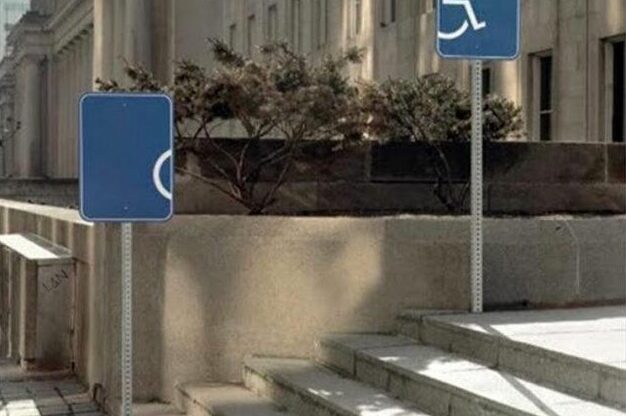- There is no such thing as “being grandfathered in” under the Americans with Disabilities Act.
- However, some businesses may be covered by something called “safe harbor.”
- To make it even more confusing, a business may comply with government guidelines but still be in violation of the ADA.
- Our ADA Expert, Marsha Mazz, is here to help you make sense of it all.
It started with a question: Why aren’t more buildings accessible?
Alex, a wheelchair user with a spinal cord injury, lives in a small midwestern town with a lot of older buildings, particularly in the downtown business district. After years of little or no progress toward accessibility, he challenged the town’s building department at a public meeting.
“Why have so few buildings been required to add accessible features, like van parking, curb cuts, and ramped entrances? It’s been over 30 years since the Americans with Disabilities Act was passed,” he asked.
The town’s chief building inspector told him they were grandfathered in because those buildings were so old. “For the most part, the owners don’t have to make any improvements unless they apply for a permit to alter the building,” she said. “Even then, it depends on the amount and type of changes they want to make to the building.”
The inspector used the example of a shoe store that closes and reopens as a coffee shop. “That would probably be a major alteration. The owner would have to upgrade all sorts of systems, including plumbing, electrical, fire protection, and accessibility. On the other hand, if the owner only wanted to upgrade the air conditioning, they wouldn’t have to make any changes to increase accessibility.”
Knowing that couldn’t be right, Alex contacted United Spinal Association for clarification.
Right on code, wrong on law
The ADA is a civil rights law that removes barriers so people with disabilities can participate equally in society — including selling textiles if they’d like.
Like many people, neither Alex nor the chief building official understood the distinction between local building code enforcement and federal civil rights protections.
Alex asked why the ADA hadn’t had the expected effect. However, because so many of us use “ADA” as a shorthand to mean “accessibility” in general, the building official assumed he was asking about the building code’s accessibility requirements.
The answer Alex got was correct for the building code and completely incorrect for the ADA.
The ADA requires “public accommodations” like downtown businesses built before the effective date of the ADA Standards (January 26, 1993) to remove barriers. This includes architectural barriers when doing so is “readily achievable.” That means when it is cheap and easy, with all their resources taken into consideration.
Unlike a building code, the ADA demands barrier removal up front, even if the building owner or business operator plans no other changes to the building.
The ADA, a civil rights law, doesn’t wait for that business owner or operator to decide they need a new snazzy storefront before the entrance must be made accessible. Moreover, if a public accommodation does not remove a barrier, that barrier remains an unfulfilled obligation until it is removed.
Remember, all the public accommodation’s resources must be considered when making a barrier removal decision. If a business does not remove a barrier and new resources become available, that changes the calculus.
What’s the difference between “grandfathered in” and safe harbor?
The ADA Standards have evolved.
The first edition of the ADA Standards, published in 1991, included some provisions that were revised in the 2010 ADA Standards. These changes addressed minor conflicts with state and local codes and standards or unanticipated compliance issues. The Department of Justice called these “incremental changes” and created a “safe harbor” for building elements that complied with the earlier requirements before the effective date of the 2010 ADA Standards. As a result, elements that complied with the 1991 ADA Standards before the effective date of the 2010 ADA Standards are not subject to barrier removal. This is true even if the corresponding requirement in the 2010 ADA Standards is more stringent.
However, there is no “safe harbor” for requirements appearing for the first time in the 2010 ADA Standards. These supplemental requirements cover recreation facilities, swimming pools, miniature golf, exercise machines, and recreation boating facilities — and barrier removal applies.


